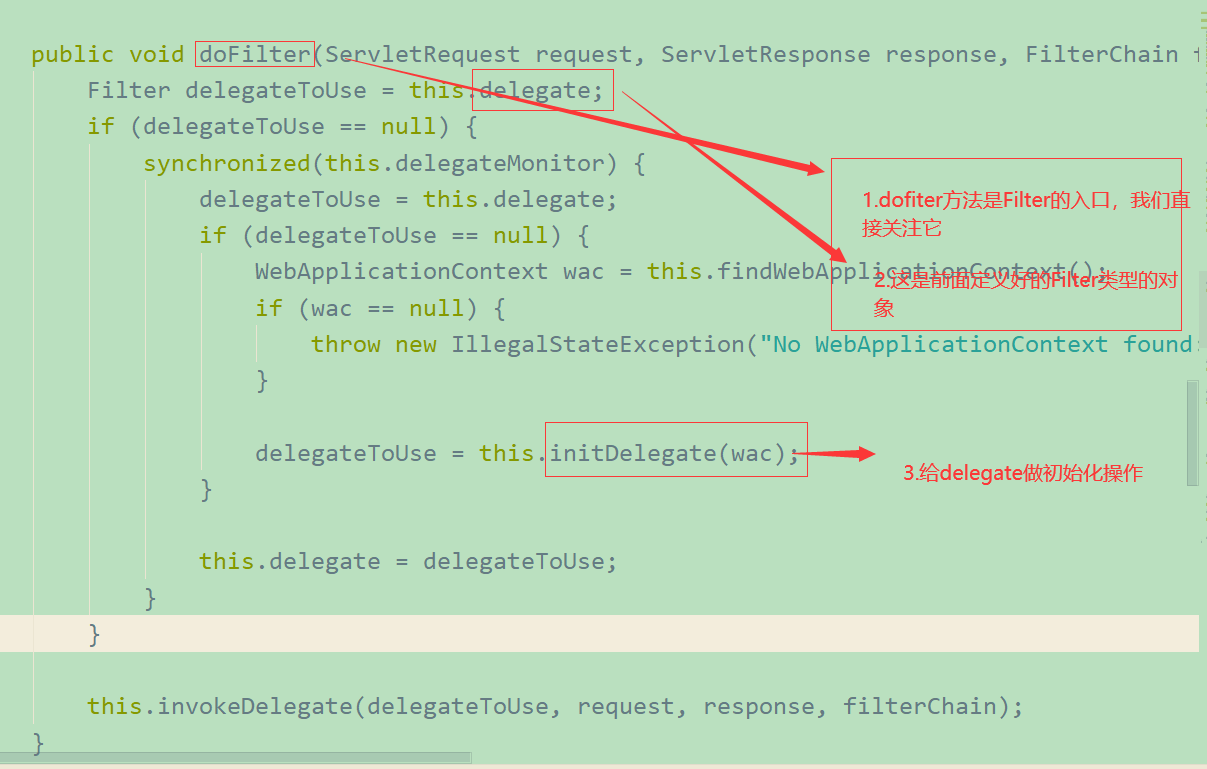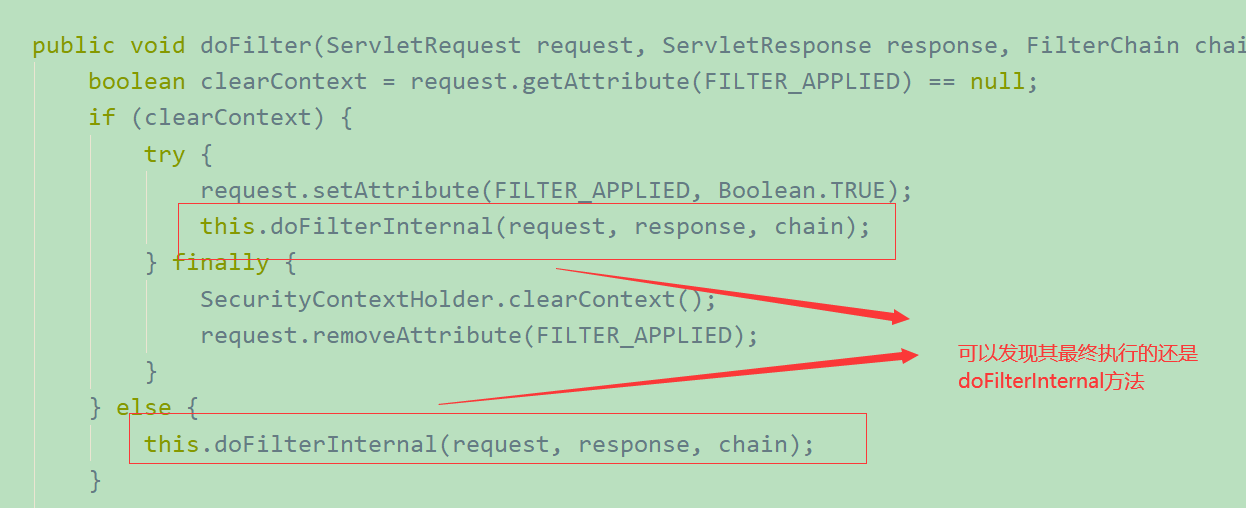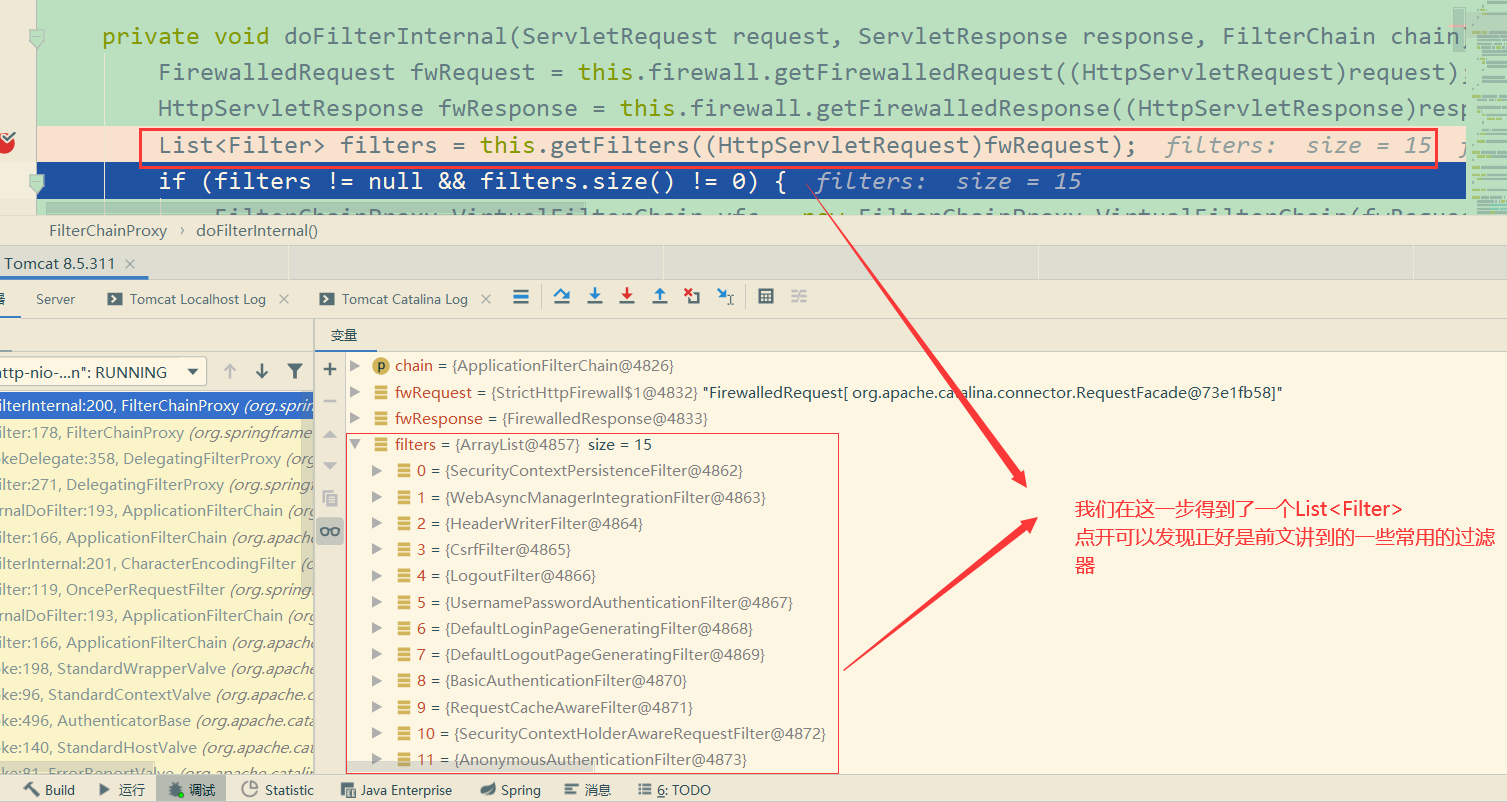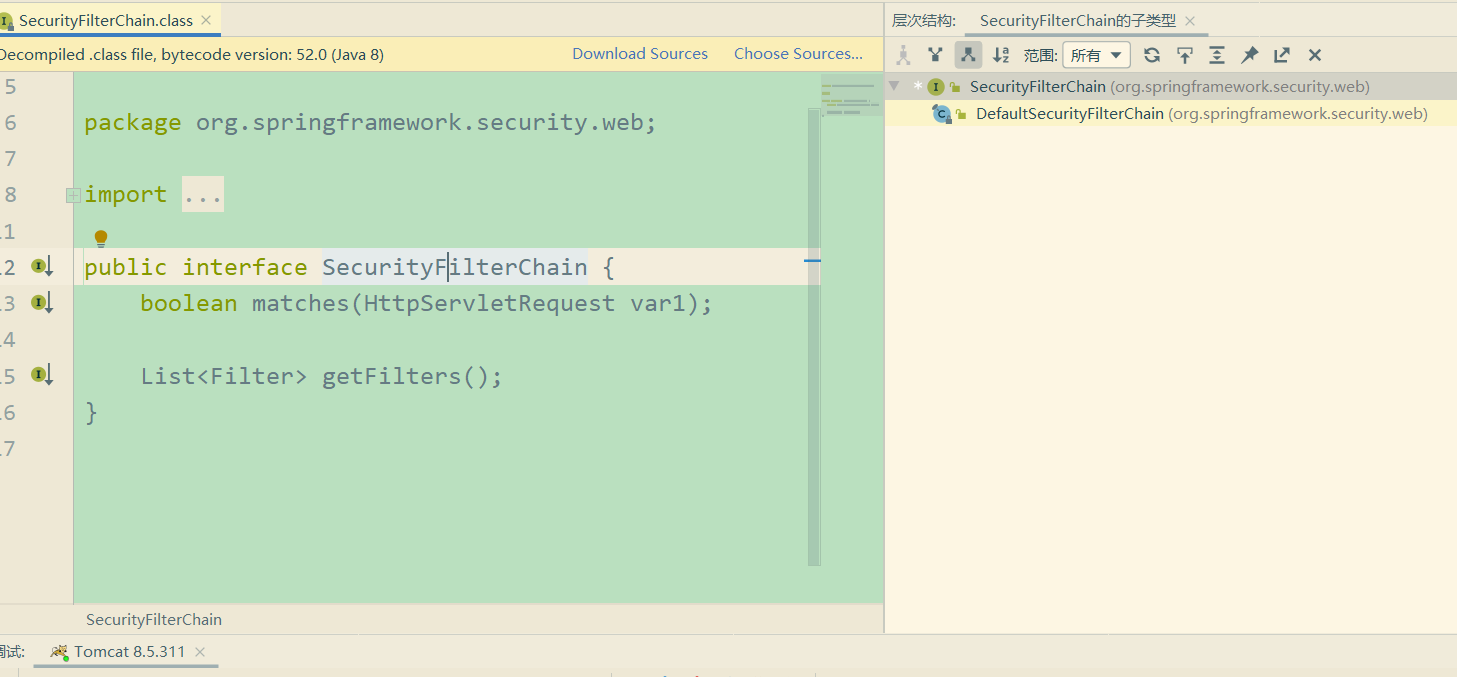Spring Security拦截器加载流程分析--练气中期
写在前面
上回我们讲了spring security整合spring springmvc的流程,并且知道了spring security是通过过滤器链来进行认证授权操作的。今天我们来分析一下springsecurity过滤器链的加载流程。读者在阅读本文时可以边阅读边跟着操作,这样子会理解的更清楚一些。
Spring Security过滤器链
spring security的过滤器非常多,这里简单介绍几个常用的过滤器。
spring security常过滤器链介绍
org.springframework.security.web.context.SecurityContextPersistenceFilter
主要是使用SecurityContextRepository在session中保存或更新一个SecurityContext域对象(相当于一个容器),并将SecurityContext给以后的过滤器使用,来为后续filter建立所需的上下文。SecurityContext中存储了当前用户的认证以及权限信息。 其他的过滤器都需要依赖于它。在 Spring Security 中,虽然安全上下文信息被存储于 Session 中,但我们在实际使用中不应该直接操作 Session,而应当使用 SecurityContextHolder。
org.springframework.security.web.context.request.async.WebAsyncManagerIntegrationFilter
这个过滤器用于集成SecurityContext到Spring异步执行机制的WebAsyncManager 中。如果想要与spring集成,就必须要使用此过滤器链。
org.springframework.security.web.csrf.CsrfFilter
csrf又称跨域请求伪造,SpringSecurity会对所有post请求验证是否包含系统生成的csrf的token信息,如果不包含,则报错。起到防止csrf攻击的效果。
题外话:csrf攻击
CSRF(Cross-site request forgery)跨站请求伪造:攻击者诱导受害者进入第三方网站,在第三方网站中,向被攻击网站发送跨站请求。利用受害者在被攻击网站已经获取的注册凭证,绕过后台的用户验证,达到冒充用户对被攻击的网站执行某项操作的目的。
一个例子:
比如你登陆了银行网站A之后,浏览器cookie中将保存你的登录信息。同时你没有没有注销登录的情况下又用同一浏览器访问了视频网站B,假设视频网站B中含有csrf病毒,其将获取你的cookie内容,拿到你银行网站A的登录信息,就可以进行不可描述之操作了。
而这个CsrfFilter通过签发token的方式进行访问验证,如果token不是本网站签发的或者访问请求中不带有这个token则拒绝访问。
org.springframework.security.web.authentication.logout.LogoutFilter
匹配URL为/logout的请求,实现用户退出,清除认证信息。
org.springframework.security.web.authentication.UsernamePasswordAuthenticationFilter
认证操作全靠这个过滤器,默认匹配URL为/login且必须为POST请求。
org.springframework.security.web.authentication.ui.DefaultLoginPageGeneratingFilter
如果没有在配置文件中指定认证页面,则由该过滤器生成一个默认认证页面
org.springframework.security.web.authentication.ui.DefaultLogoutPageGeneratingFilter
由此过滤器可以生产一个默认的退出登录页面
org.springframework.security.web.authentication.www.BasicAuthenticationFilter
此过滤器会自动解析HTTP请求中头部名字为Authentication,且以Basic开头的头信息。
org.springframework.security.web.savedrequest.RequestCacheAwareFilter
通过HttpSessionRequestCache内部维护了一个RequestCache,用于缓存HttpServletRequest
org.springframework.security.web.servletapi.SecurityContextHolderAwareRequestFilter
针对ServletRequest进行了一次包装,使得request具有更加丰富的API
org.springframework.security.web.authentication.AnonymousAuthenticationFilter
当SecurityContextHolder中认证信息为空,则会创建一个匿名用户存入到SecurityContextHolder中。
spring security为了兼容未登录的访问,也走了一套认证流程,只不过是一个匿名的身份(游客)。
org.springframework.security.web.session.SessionManagementFilter
SecurityContextRepository限制同一用户开启多个会话的数量
org.springframework.security.web.access.ExceptionTranslationFilter
异常转换过滤器位于整个springSecurityFilterChain的后方,用来转换整个链路中出现的异常
org.springframework.security.web.access.intercept.FilterSecurityInterceptor
获取所配置资源访问的授权信息,根据SecurityContextHolder中存储的用户信息来决定其是否有权限。
spring security加载流程
在web.xml中,我们配置了一个名字为“springSecurityFilterChain”的过滤器org.springframework.web.filter.DelegatingFilterProxy。以下是部分源码。
public class DelegatingFilterProxy extends GenericFilterBean {
@Nullable
private String contextAttribute;
@Nullable
private WebApplicationContext webApplicationContext;
@Nullable
private String targetBeanName;
private boolean targetFilterLifecycle;
/** 真正加载的过滤器*/
@Nullable
private volatile Filter delegate;
private final Object delegateMonitor;
protected void initFilterBean() throws ServletException {
synchronized(this.delegateMonitor) {
if (this.delegate == null) {
if (this.targetBeanName == null) {
this.targetBeanName = this.getFilterName();
}
WebApplicationContext wac = this.findWebApplicationContext();
if (wac != null) {
this.delegate = this.initDelegate(wac);
}
}
}
}
/** 过滤器的入口 */
public void doFilter(ServletRequest request, ServletResponse response, FilterChain filterChain) throws ServletException, IOException {
Filter delegateToUse = this.delegate;
if (delegateToUse == null) {
synchronized(this.delegateMonitor) {
delegateToUse = this.delegate;
if (delegateToUse == null) {
WebApplicationContext wac = this.findWebApplicationContext();
if (wac == null) {
throw new IllegalStateException("No WebApplicationContext found: no ContextLoaderListener or DispatcherServlet registered?");
}
/** 在做完一系列判断之后,真正要做的就是这一步,初始化delegate*/
delegateToUse = this.initDelegate(wac);
}
this.delegate = delegateToUse;
}
}
this.invokeDelegate(delegateToUse, request, response, filterChain);
}
protected Filter initDelegate(WebApplicationContext wac) throws ServletException {
String targetBeanName = this.getTargetBeanName();
Assert.state(targetBeanName != null, "No target bean name set");
Filter delegate = (Filter)wac.getBean(targetBeanName, Filter.class);
if (this.isTargetFilterLifecycle()) {
delegate.init(this.getFilterConfig());
}
return delegate;
}
protected void invokeDelegate(Filter delegate, ServletRequest request, ServletResponse response, FilterChain filterChain) throws ServletException, IOException {
delegate.doFilter(request, response, filterChain);
}
}

接下来我们在initDelegate方法上打个断点调试一下


最终我们发现,通过initDelegate方法给delegate初始化,得到一个FilterChainProxy对象。接下来我们进入FilterChainProxy这个类看看
public class FilterChainProxy extends GenericFilterBean {
。。。。
}
可以发现这也是一个过滤器,那么我们找dofilter方法。

接下来我们在doFilterInternal里面打个断点试试,看看能不能得到过滤器链

我们在这一步得到了一个List
我们再进入到getFilters中看看这些过滤器链在哪
private List<Filter> getFilters(HttpServletRequest request) {
Iterator var2 = this.filterChains.iterator();
SecurityFilterChain chain;
do {
if (!var2.hasNext()) {
return null;
}
chain = (SecurityFilterChain)var2.next();
} while(!chain.matches(request));
return chain.getFilters();
}
从该方法我们知道过滤器链来自于SecurityFilterChain的getFilters方法,接下来,我们看看这个类
public interface SecurityFilterChain {
boolean matches(HttpServletRequest var1);
List<Filter> getFilters();
}
可以发现这是一个接口,在idea中ctrl+H可以发现它只有一个实现类,那就是DefaultSecurityFilterChain

到这一步,我们可以发现,springSecurity的过滤器链存在于SecurityFilterChain中(springSecurity的过滤器链由SecurityFilterChain负责封装),它只有一个实现类那就是DefaultSecurityFilterChain。也就是说其过滤器链由SecurityFilterChain封装。
至此,springSecurity的过滤器链加载流程我们就说完了。



